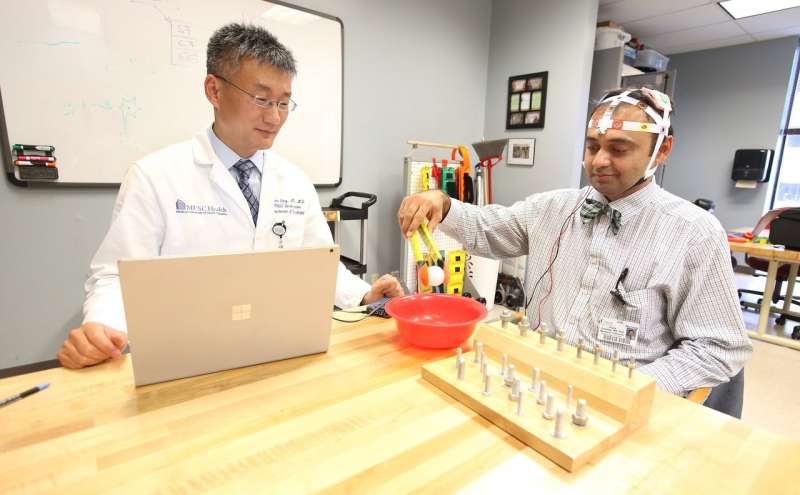Detection of transcranial direct current stimulation deep in the living human brain

A defining characteristic of stroke is the loss of motor control due to structural damage in specific brain areas. In fact, motor impairments (or deficits) are the number one complication after stroke. Losing the ability to carry out basic bodily functions, such as speaking, walking and swallowing, can be devastating for stroke survivors. Unfortunately, there are few effective recovery options beyond physical and occupational therapy to stimulate brain re-learning. While many researchers have tried to identify effective new therapies to mitigate motor function impairment and enhance quality-of-life, discoveries have been lacking.
Because the neural circuitry of the brain operates via electro-stimulation, applying small amounts of electrical current to the scalp (transcranially) has been investigated as a means of modulating brain activity. However, although there are promising tDCS data, the optimal dosing remains unknown. Furthermore, it is unclear what amount of scalp-applied current can penetrate the brain. To answer these questions, a team of MUSC investigators led by stroke neurologist and physician-scientist Wayne Feng, M.D., MS, attempted something that has never before been tried - they directly measured tDCS-generated EFs in vivo using deep brain stimulation (DBS) electrodes that were already implanted in patients with Parkinson's disease. Their findings provide direct evidence that helps answer some of the long-standing, daunting questions in the field.
"There are tons of studies on tDCS for stroke, depression, and pain control, but there's a lot of skepticism about using tDCS clinically because the data are mixed," explains Feng. The main problem is that it is extremely difficult to measure electrical activity deep inside the brain of a living person, and differences between the brains of living people and those of the animals and cadavers that previous studies have used are significant. Although models predict that tDCS would generate EFs throughout the brain, there is no direct evidence demonstrating or measuring these electric fields in a living person's brain.
"Until now, we didn't know what the optimal dose of current was because we didn't how much current was really getting through the scalp and skull and penetrating inside the brain. The skull bone and scalp thickness, the shape of the skull, brain size—all of these things affect it. So, without really being able to measure the current in live patients, we were simply guessing," says Feng.
Then, Feng recognized a novel opportunity to directly measure whether tDCS generates EFs in deep brain areas among patients with movement disorders such as Parkinson's disease, who are often treated by implanting DBS electrodes.
"These patients provide a natural experimental model that gave us a chance to use their implanted electrodes to record how much externally applied tDCS current actually reaches the thalamic and subthalmic regions," says Feng.
But conducting this experiment was no simple task. Surgery to implant DBS electrodes is conducted in two steps. First, electrodes are inserted and the patient is sent home for one to two weeks while they stabilize. Then, the patient returns to connect the electrodes in their brain to a battery implanted in the chest wall. Feng's team cleverly took advantage of a 15-20-minute window during the second surgical procedure, before the surgeon connected the battery to the electrodes, to connect the electrodes to a recording device while applying the direct current through the scalp at different current levels using two different montages (pad placements). This way, the experiment could be conducted without deviating from standard clinical care or jeopardizing patient safety.
"The normal variation in surgical time for this type of procedure is 15-20 minutes, so that's all generous time we could have from the neurosurgeon," says Feng. "We mapped out the EF strength using the permutation of eight contact leads (four on each electrode), and then we changed the position of the tDCS pads on the scalp to see if moving the pad location (the montage) changed the EF distribution. It was quite challenging to do. It took us over two years to collect data on five patients."
Although arduous to collect, these data represent the first report in living humans of scalp-delivered tDCS voltage measurements across DBS electrodes at the subcortical level. They demonstrate that scalp tDCS produces an EF deep in the brain in a dose-dependent and montage-specific manner. In other words, 4 mA current produced about twice as much voltage change across electrodes as 2 mA current and the bi-temporal montage provided higher voltage differences than the occipitofrontal montage. "We showed that the signal increases with more amplitude and that the increase was proportional and montage dependent. This is important when you are treating different diseases, because the location of the pads really matters. Different pad placements create different EFs with different strengths," says Feng.
This direct evidence of EFs occurring inside the living human brain when tDCS is applied through the scalp dispels the previous belief that most of the current is shunted before it penetrates the skull and only reaches the cortex. In addition, it provides real human data against which modeling assumptions can be tested. Feng anticipates that the information from this study and his next investigations to validate and optimize current tDCS modeling will greatly advance the field.
"I hope that, in the future, we can get an image of the patient's brain and apply a computational model to indicate the exact amount of current and montage that a stroke patient needs for motor recovery. It would be a precision neuro-modulation approach for stroke recovery," says Feng.
Feng also points out that, although his focus is motor function recovery after stroke, tDCS has also been studied for treating various disease conditions, such as depression, and for post-surgical pain control to reduce the use of pain medication.
More information: Pratik Y. Chhatbar et al, Evidence of transcranial direct current stimulation-generated electric fields at subthalamic level in human brain in vivo, Brain Stimulation (2018). DOI: 10.1016/j.brs.2018.03.006















